Automated customer journey mapping tools help businesses understand and improve how customers interact with their brand. These tools provide real-time insights, automate processes, and integrate with existing systems like CRMs to optimize customer experiences. Here’s a quick summary of the top tools and their standout features:
- Fullstory: Tracks user behavior with session replays and heatmaps. AI predicts conversion likelihood. Starts at $199/month.
- Miro: Collaborative platform with templates for journey mapping. Integrates with over 100 apps. Plans from $8/user/month.
- Heap: Automatically tracks user actions without manual tagging. Retroactive analytics included. Paid plans start at $3,600/year.
- Smaply: Focused on persona creation and journey analytics. Free plan available; paid plans start at $34/user/month.
- TheyDo: Combines journey management with automation and smart templates. Pricing starts at $49/user/month.
- Figma: Known for design collaboration, it supports visual journey mapping. Plans start at $12/user/month.
- Microsoft Dynamics 365 Customer Insights: Enterprise-level tool with predictive AI for customer behavior. Pricing starts at $95/user/month.
- Adobe Experience Platform: Offers real-time data processing and journey orchestration. Custom pricing starts around $150,000/year.
- Qualtrics XM Platform: Combines feedback management with AI-driven insights. Pricing starts at $1,500/year.
- Hatrio Sales: Designed for sales teams with CRM, lead generation, and automation. Free trial available; plans start at $99/month.
Quick Comparison
| Tool | Core Features | AI Capabilities | Pricing (USD) | Best For |
|---|---|---|---|---|
| Fullstory | Heatmaps, session replays | Conversion predictions | $199/month | E-commerce and SaaS companies |
| Miro | Visual collaboration, templates | Limited AI suggestions | $8/user/month | Cross-functional teams |
| Heap | Auto event tracking, retroactive | Conversion optimization | $3,600/year | Data-driven organizations |
| Smaply | Persona creation, journey analytics | Basic pattern recognition | $34/user/month | Service design teams |
| TheyDo | Journey management, collaboration | Opportunity identification | $49/user/month | Product teams |
| Figma | Design, prototyping | AI-assisted design | $12/user/month | Design teams |
| Microsoft Dynamics 365 | Predictive scoring, CRM integration | Advanced customer predictions | $95/user/month | Enterprises |
| Adobe Experience Platform | Real-time data, orchestration | Adobe Sensei personalization | $150,000/year+ | Large enterprises |
| Qualtrics XM Platform | Feedback management | Text analytics, predictions | $1,500/year | Feedback-focused organizations |
| Hatrio Sales | CRM, lead generation | Lead scoring, automation | $99/month | Sales teams |
These tools cater to different needs, from small teams to large enterprises. Choose based on your goals, budget, and technical requirements.
Top 11 Customer Journey Mapping Tools to Get User Insights
1. Fullstory
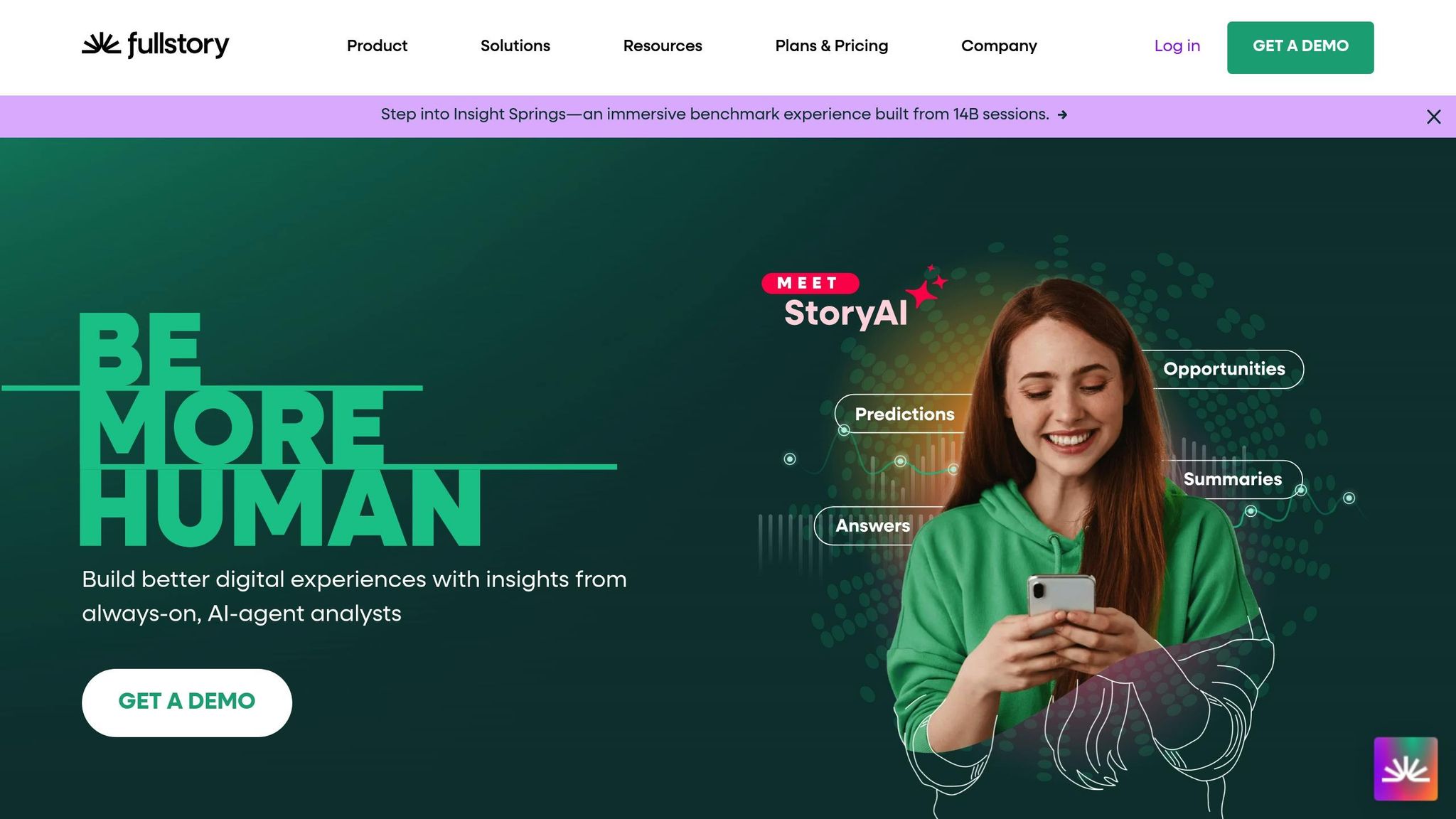
Fullstory is a digital experience intelligence platform designed to capture every click, scroll, and interaction on your digital platforms. By recording complete user sessions, it provides a detailed look into how prospects behave during their buying journey.
With heatmaps and session replays, Fullstory highlights how users engage with your content, pinpointing areas of interest and moments where they lose interest. This level of detail helps sales teams understand the emotional highs and lows of the customer experience, making it easier to spot issues that could be costing you deals. Let’s dive into how Fullstory's automation features can enhance your understanding of user behavior.
Automation Capabilities
Fullstory’s automation engine monitors user behavior in real time, flagging unusual patterns and segmenting users automatically. It can detect key buying signals, such as a prospect spending extra time on pricing pages or repeatedly viewing product demos, and then trigger alerts for your sales team to act on.
This ensures sales teams have access to up-to-date insights without needing to manually sift through data.
AI/ML Features
Using machine learning, Fullstory identifies behavioral anomalies and trends that might go unnoticed by human analysts. It can even predict the likelihood of conversion based on user interaction patterns, helping sales teams prioritize leads more effectively.
The platform also includes smart search functionality, allowing teams to find specific user sessions using natural language queries. For instance, you could search for "users who visited the pricing page three times but didn’t sign up" and immediately access relevant session replays for analysis.
Integration Options
Fullstory integrates seamlessly with popular CRMs like Salesforce, HubSpot, and Marketo, syncing behavioral data directly into your existing customer records. This ensures sales teams can view a prospect’s digital activity within the tools they already use.
Additionally, Fullstory’s API allows for custom integrations with proprietary sales tools and databases, making it a flexible choice for businesses with unique workflows.
Pricing (USD)
Fullstory offers a free tier that includes up to 1,000 monthly sessions with basic replay and heatmap features. For more robust needs, the Business plan starts at $199 per month, covering up to 5,000 monthly sessions and including advanced search, conversion funnels, and integrations.
For larger organizations, custom Enterprise pricing is available. This tier provides advanced security, dedicated support, and higher session limits. Most mid-size sales teams find the Business plan ideal for mapping the customer journey across critical touchpoints.
2. Miro
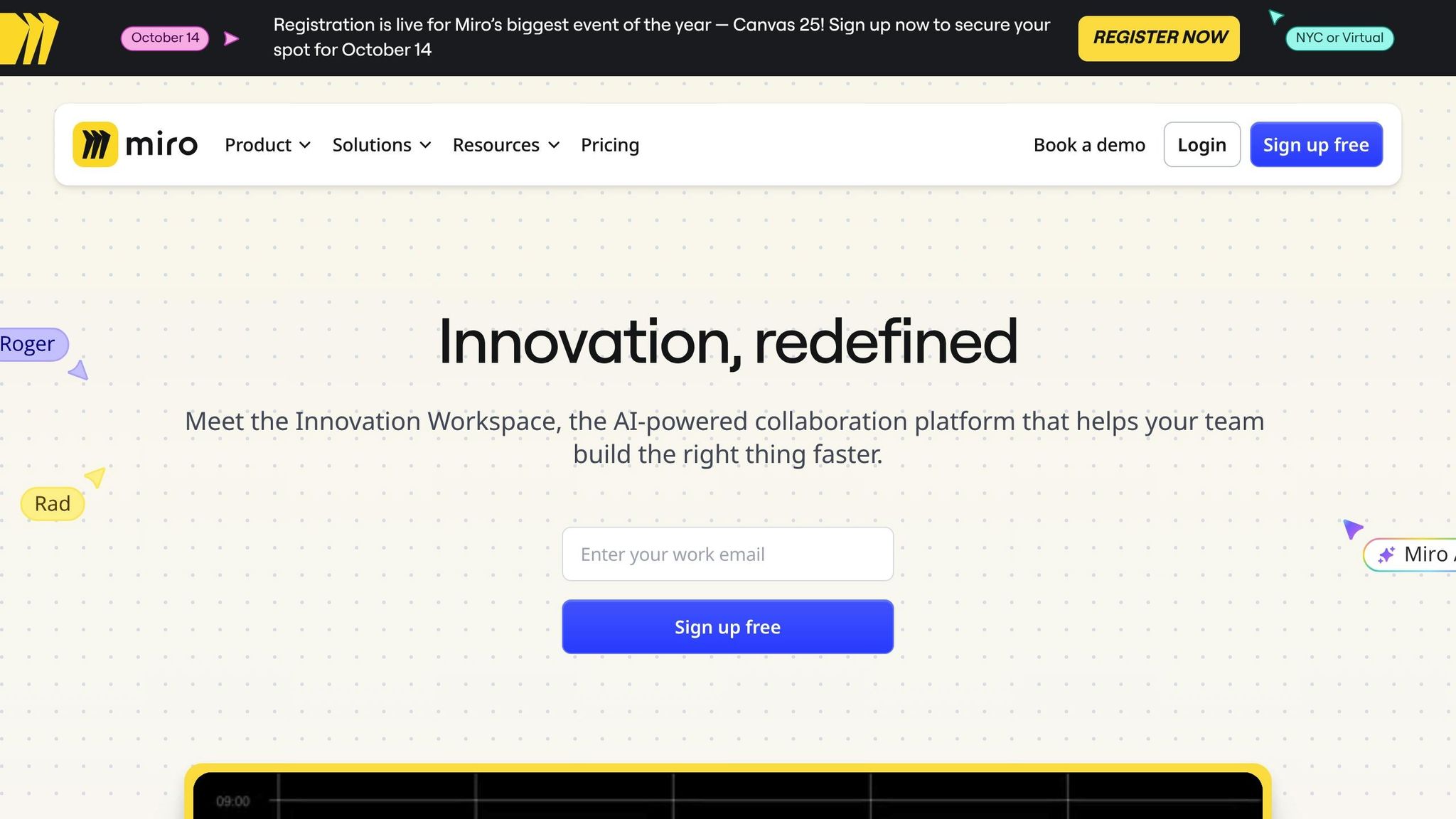
Miro simplifies automated customer journey mapping by allowing teams to collaboratively create and update interactive maps in real time. Whether it's sales, marketing, customer success, or product teams, everyone can contribute to building detailed maps that cover every touchpoint in the customer experience, offering a full view of the buying process.
To make things even easier, Miro provides a library of ready-made templates. These range from straightforward journey maps to complex multi-persona frameworks, giving teams the flexibility to pick a structure that fits their unique sales workflows and customer profiles.
Automation Capabilities
Miro includes automation tools like workflow triggers and smart notifications to keep projects on track. For example, when a touchpoint or persona is updated, stakeholders are automatically notified.
Another handy feature is Smart Drawing, which transforms rough sketches into professional-looking diagrams. This not only saves time during brainstorming sessions but also ensures the maps look polished and consistent.
Integration Options
Miro integrates seamlessly with over 100 business apps, including Salesforce, HubSpot, Microsoft Teams, Slack, and Zoom. These connections allow teams to pull live customer data directly into their journey maps, ensuring the visuals accurately reflect customer interactions and sales pipeline updates.
For businesses with unique tools, Miro's API and webhooks enable custom integrations, making it possible to automate data flow between internal systems and journey maps. These integrations help streamline processes and keep everything aligned.
Pricing (USD)
Miro offers a free plan that supports up to 3 editable boards with unlimited team members, making it a great option for smaller teams.
- Starter Plan: $8 per member/month (billed annually) includes unlimited boards, advanced templates, and basic integrations.
- Business Plan: $16 per member/month, designed for growing teams, adds enhanced collaboration tools, custom templates, and extra security features.
- Enterprise Plan: Starting at $24 per member/month, it offers advanced admin controls, single sign-on, and dedicated customer support.
For most sales teams, the Business plan strikes the right balance, offering the tools and features needed for effective customer journey mapping.
3. Heap
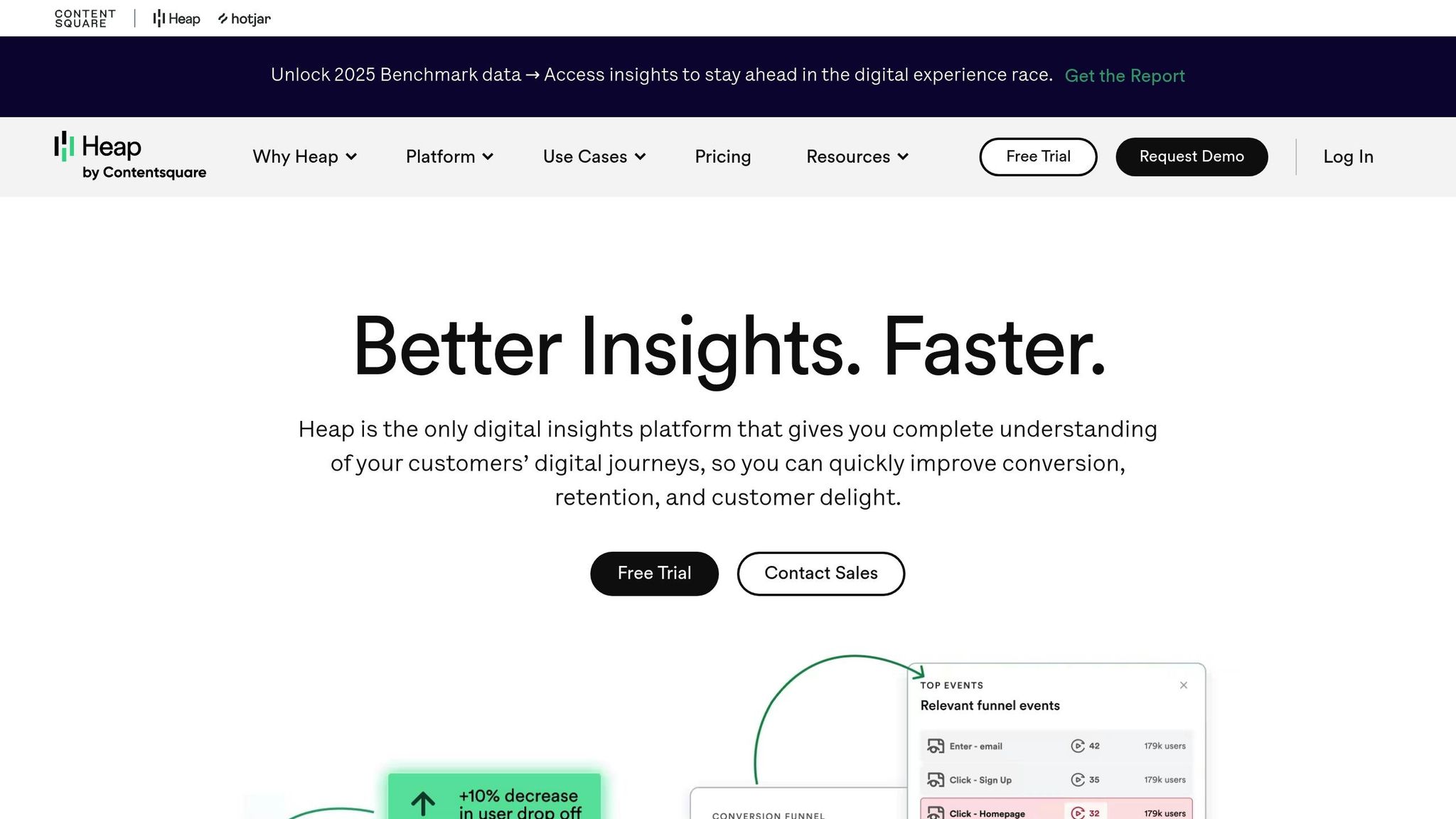
Heap is a digital analytics platform designed to automatically track user interactions on websites and mobile apps without the need for manual event tagging. By continuously capturing data, it provides a clear picture of how users navigate through various digital touchpoints.
Unlike traditional analytics tools that rely on developers to tag specific events, Heap's retroactive analytics allow businesses to analyze past user behavior. This feature helps uncover unexpected sales funnel paths and identify obstacles that might be affecting conversions.
Automation Capabilities
Heap simplifies data collection by automatically tracking clicks, form submissions, and page views. Its smart segmentation feature groups users based on their behavior. For instance, it can identify users who frequently visit a pricing page but don’t convert, giving sales teams the insights they need to fine-tune follow-up strategies.
The platform also excels in conversion funnel analysis, pinpointing where users drop off in multi-step processes like checkout flows or demo requests. This helps teams quickly address areas of friction and improve the overall customer experience.
AI and Machine Learning Features
Heap leverages machine learning to detect behavioral patterns and highlight deviations that could signal technical issues or emerging trends. These insights help teams focus on high-value prospects and adjust their outreach strategies to be more effective.
Integration Options
Heap connects seamlessly with various third-party tools, including popular CRM systems, marketing automation platforms, and customer support software. This integration capability enables businesses to combine behavioral data with other sales and marketing insights, offering a complete view of the customer journey - from the first website visit to closing a deal. Such connectivity ensures that data flows smoothly, especially when evaluating pricing options.
Pricing (USD)
Heap provides a free tier with essential features, making it accessible for smaller teams or those just starting out. Paid plans are available for organizations with more extensive data needs, offering advanced segmentation, funnel analysis, and integrations. For larger enterprises, custom plans are available to handle higher data volumes and more complex requirements.
Heap’s combination of automated tracking, behavioral insights, and integration flexibility makes it an excellent choice for teams aiming to better understand and optimize their customer journeys.
4. Smaply
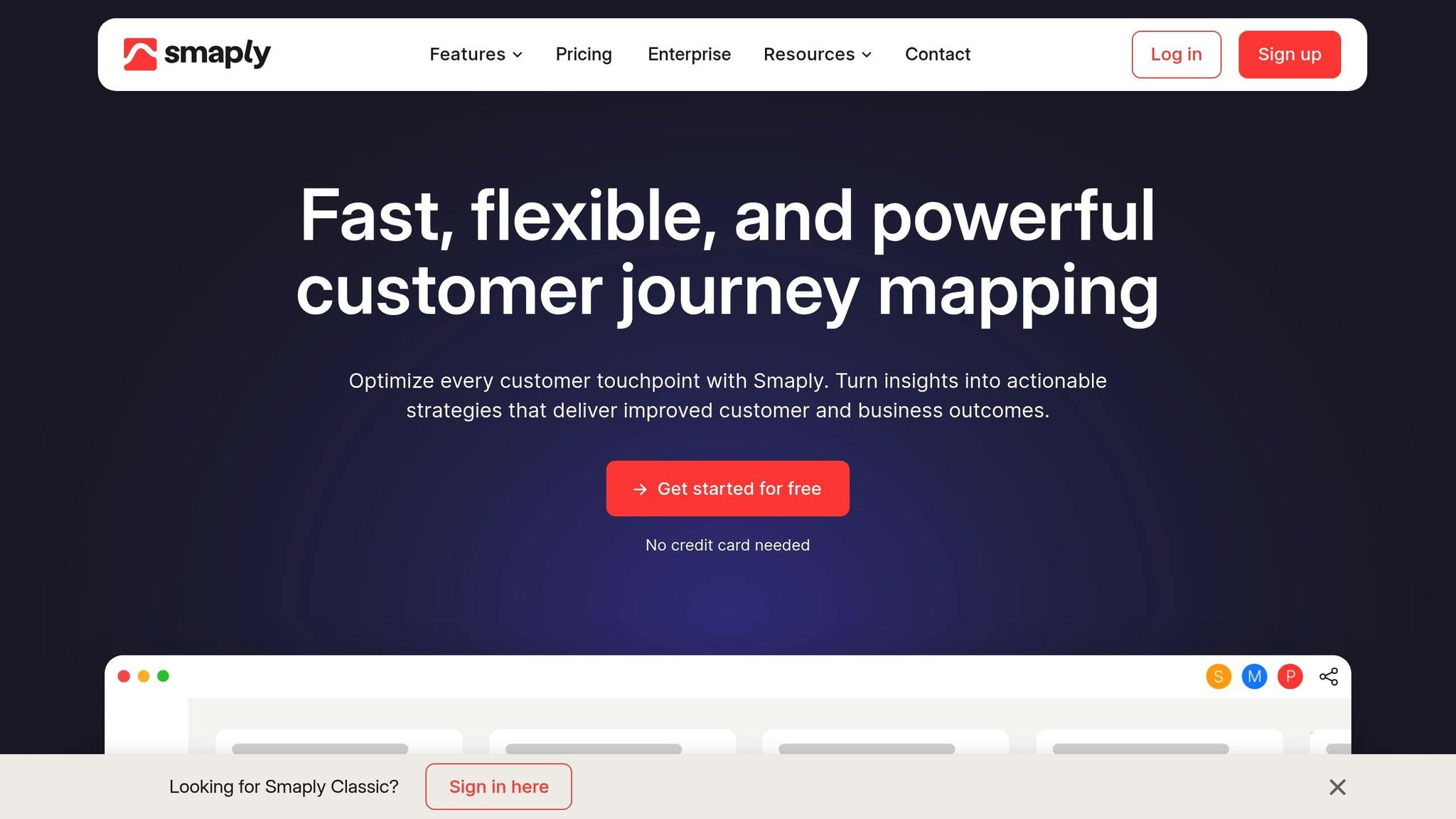
Smaply provides flexible pricing options tailored for teams of various sizes and project scopes. With four distinct plans, it accommodates everything from small teams to large-scale collaborations.
Pricing (USD)
Here’s a breakdown of Smaply’s pricing:
- Free Plan: $0 – Includes basic journey mapping features. No credit card required.
- Repository Plan: $34 per editor per month (billed annually at $399).
- Framework Plan: $59 per editor per month (billed annually at $699).
- Governance Plan: $84 per editor per month (billed annually at $999).
For larger teams or organizations, Smaply offers volume discounts, making it more cost-effective for groups with 20 or more users.
"Easily start with the free plan, switch between plans anytime. No credit card needed for free signup. All prices are net per user. VAT will be added if applicable."
Additional discounts are available for specific groups:
- Educational institutions: Up to 100% off.
- NGOs: Up to 50% off.
- Public services: Up to 20% off.
- Collaborative case study partnerships: Special rates apply.
This flexible pricing structure ensures accessibility for a wide range of organizations and teams.
5. TheyDo
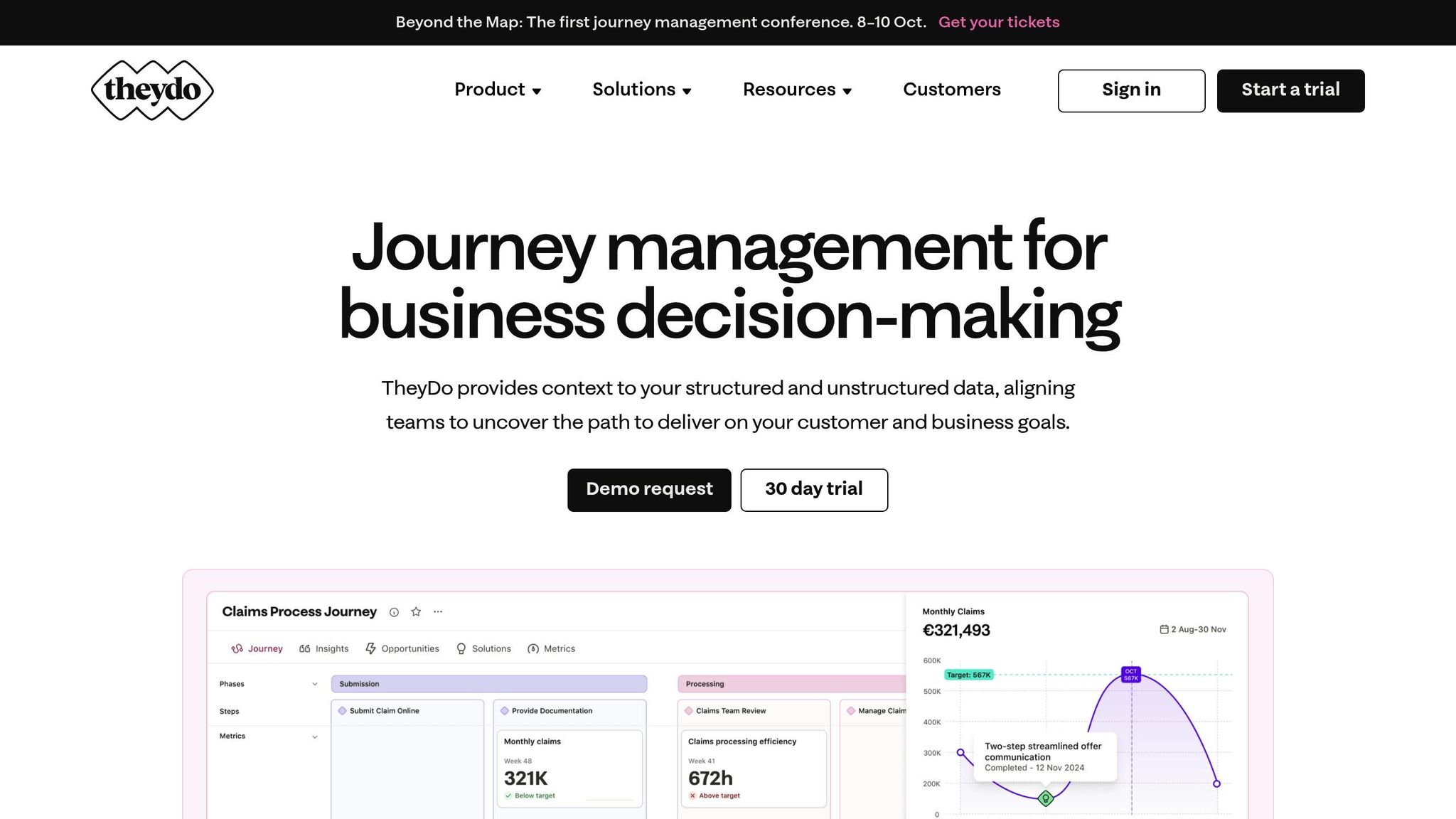
TheyDo is a journey management platform designed to help teams visualize and manage customer journeys more effectively. By combining visual mapping tools with data-driven automation, it simplifies the process of understanding and improving customer interactions.
Automation Capabilities
TheyDo takes the hassle out of journey mapping with automated data collection and real-time collaboration features. Its smart templates are tailored for various industries, offering a head start on mapping processes. Automated reporting ensures you can generate actionable insights without spending hours on manual analysis. These automation tools make it easy to integrate the platform into your workflow.
Integration Options
TheyDo works seamlessly with a variety of business tools, including web analytics platforms, customer support software, project management tools, and CRM systems. These integrations ensure that customer data flows directly into your journey maps, creating a unified view of the customer experience. This connectivity enhances the platform's usability and makes it a valuable tool for businesses of all sizes.
Pricing
TheyDo provides flexible pricing plans to accommodate teams of different sizes and needs. A free trial is available, allowing you to test the platform before committing. For detailed pricing information and to find the plan that fits your organization best, you can reach out to their sales team directly.
6. Figma
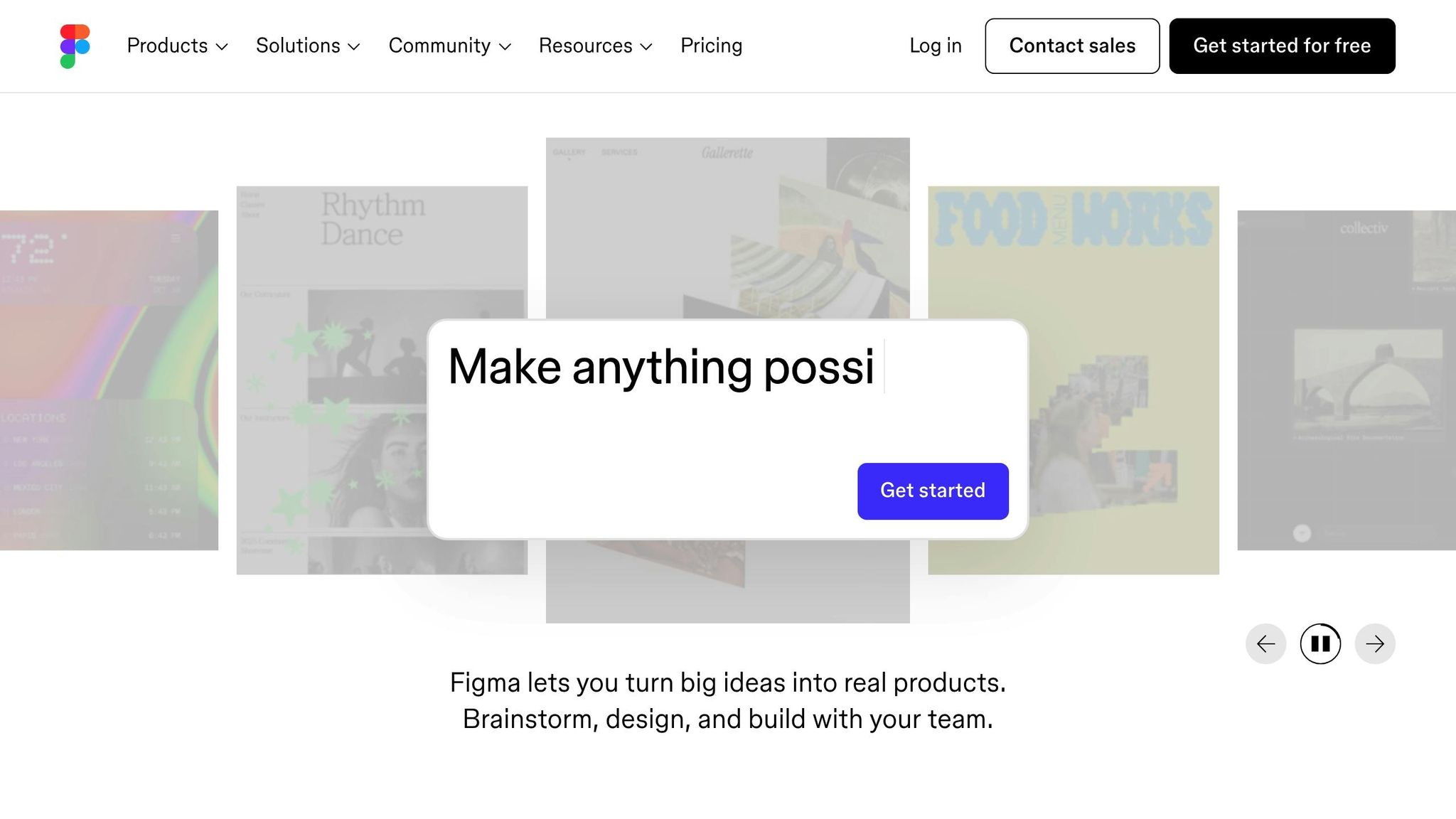
Figma provides a collaborative platform that works well for customer journey mapping, offering tools that many teams find effective. While it's primarily recognized as a design tool, its real-time collaboration and flexible canvas make it a great choice for visualizing customer touchpoints and experiences. Its design-first approach brings a fresh perspective to mapping customer interactions. Teams across design, marketing, and product departments can work together simultaneously, making it a strong option for cross-functional projects.
What sets Figma apart is its visual flexibility and user-friendly interface. You can build detailed customer personas, outline complex user flows, and even create interactive prototypes that illustrate how customers move through various stages of their journey. The platform's infinite canvas ensures you can map even the most intricate customer experiences without worrying about space limitations. This collaborative setup is further enhanced by Figma's automation features.
Automation Capabilities
Figma's automation tools are built around component libraries and design systems, which help speed up the journey mapping process. Features like auto-layout adjust spacing and alignment automatically as you add or remove elements, while automatic version control saves every iteration, allowing you to revert to earlier versions easily.
Reusable components for common elements - such as touchpoints, pain points, and decision nodes - can be duplicated and customized across different maps. This not only saves time but ensures consistency. With these features, your team can keep maps up-to-date while retaining access to past versions for reference.
Integration Options
Figma excels at integrating with other tools, making it easy to bring in real customer data or workshop outputs. You can import data from platforms like Google Sheets, Notion, Airtable, and Miro, which helps populate your journey maps with meaningful insights. This streamlines the process of turning raw data into polished, actionable visualizations.
For technical teams, Figma includes developer handoff tools that simplify the transition from journey mapping to implementation. The platform generates CSS code and design specifications automatically, bridging the gap between your mapping insights and the actual execution of customer experience improvements.
Pricing (USD)
Figma offers a free tier, which includes up to 3 Figma files and 3 FigJam files. This is a great starting point for small teams exploring journey mapping. The Professional plan, priced at $12 per editor per month (billed annually), unlocks unlimited files, advanced prototyping features, and team libraries to boost collaboration.
For larger teams, the Organization plan costs $45 per editor per month and adds features like advanced security, centralized file management, and analytics to track how teams are using journey mapping resources. For companies with more complex needs, Enterprise pricing is available, offering custom security controls and dedicated support tailored to larger organizations.
sbb-itb-b22f30c
7. Microsoft Dynamics 365 Customer Insights
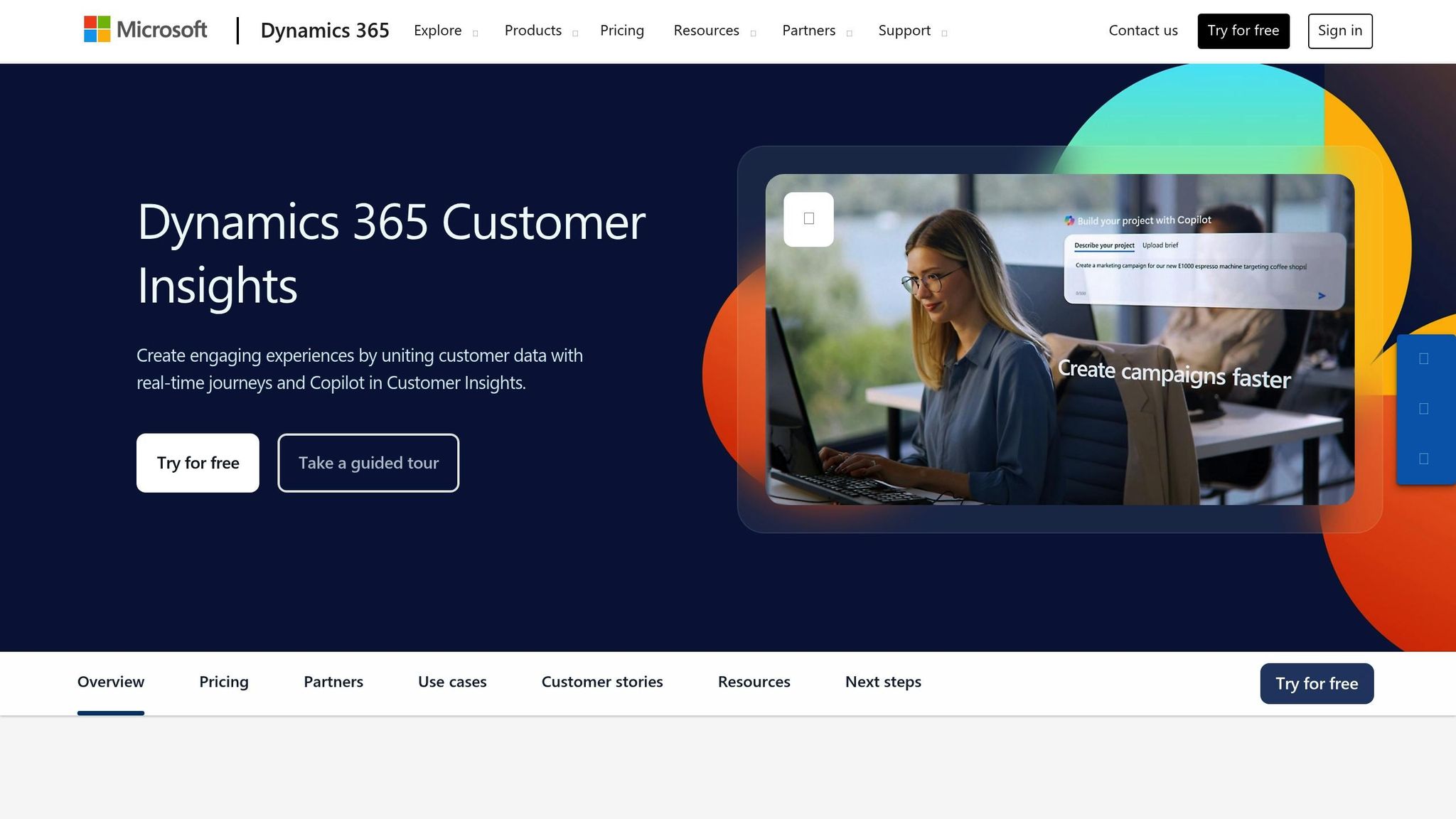
Microsoft Dynamics 365 Customer Insights gives businesses a complete view of their customer journeys. This enterprise solution combines advanced data unification with cutting-edge analytics, making it especially useful for organizations handling complex, multi-channel interactions. One of its standout features is its ability to eliminate data silos, offering a clearer picture of customer behavior through its AI-powered tools.
The platform processes data from various sources - websites, mobile apps, emails, social media, and even offline interactions - identifying patterns in customer behavior automatically. This holistic approach helps businesses pinpoint friction points and discover opportunities that might otherwise be overlooked.
What truly sets Dynamics 365 Customer Insights apart is its real-time processing. It ensures customer journey maps are continuously updated as new interactions occur, keeping businesses aligned with evolving customer needs and market conditions. This real-time capability bridges the gap between data collection and actionable insights.
AI/ML Features
The platform's AI and machine learning features take customer journey insights to the next level. With predictive analytics, it forecasts customer behaviors and trends, allowing businesses to anticipate issues and address them proactively.
Machine learning also plays a key role in creating dynamic customer segments based on behavior, preferences, and journey stages. Unlike traditional static segments that require manual updates, these AI-driven segments adapt automatically as customer behaviors change. This ensures journey maps remain accurate and reflective of real-time customer dynamics.
Another valuable feature is anomaly detection, which flags irregularities in customer behavior. This allows teams to investigate and resolve potential problems quickly.
Integration Options
Dynamics 365 Customer Insights integrates seamlessly with Microsoft tools like Office 365, Power BI, and Azure. This integration allows journey insights to flow directly into the tools teams already use for reporting, collaboration, and decision-making. For example, Power BI integration enables businesses to create interactive dashboards that combine customer journey data with key business metrics.
The platform also supports third-party applications through pre-built connectors and APIs, making it easy to incorporate data from various systems. For businesses using Azure, the integration is even more robust, allowing journey data to be combined with other analytics tools, machine learning models, and data warehousing solutions. This creates a comprehensive environment for business intelligence.
Pricing for the platform depends on usage.
8. Adobe Experience Platform
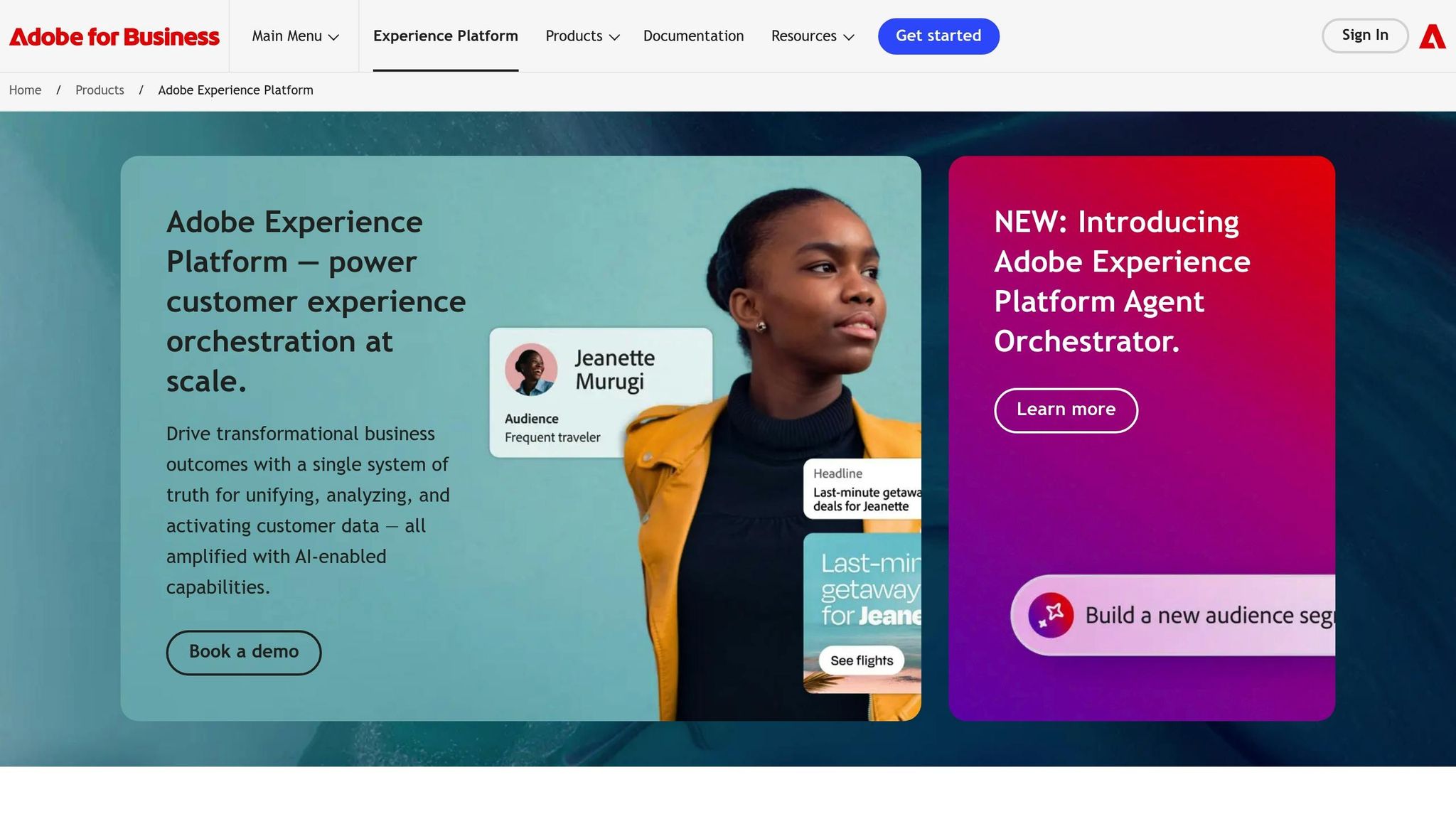
Adobe Experience Platform is designed for enterprises looking to manage complex customer journeys across multiple touchpoints. It shines in real-time data processing, creating unified customer profiles that update instantly across all channels.
With its powerful architecture, the platform can handle vast amounts of data from sources like websites, mobile apps, email campaigns, and social media. This allows businesses to get a complete view of the customer journey, pinpoint areas where conversions may be falling short, and fine-tune the touchpoints that matter most. This foundational setup also enables advanced automation.
One standout feature is Journey Orchestration, which responds to real-time customer actions with automated, personalized interactions. For instance, if a customer abandons their cart, the system can trigger tailored emails, update website content, or send sales notifications to re-engage them.
Automation Capabilities
The platform takes automation to the next level, going beyond simple triggers. By using real-time data and predictive models, Adobe Experience Platform ensures that journey maps are more than static visuals - they function as dynamic plans that drive automated decisions.
Its Audience Manager feature automatically updates customer segments based on their behavior and journey stage. These segments integrate seamlessly with marketing tools, ensuring timely and relevant messaging. For example, campaigns can be paused for customers who’ve already converted, or high-value prospects can be flagged for sales teams.
The platform also ensures cross-channel orchestration, maintaining consistent messaging across all touchpoints. This eliminates the disjointed experiences that can frustrate customers.
AI/ML Features
Adobe Sensei, the platform’s AI engine, brings advanced analytics to the table. It detects subtle patterns in customer behavior, such as signs of potential churn or the likelihood of a purchase. These insights allow businesses to adjust their strategies proactively, minimizing revenue loss.
Predictive scoring is another key feature. It assigns real-time probabilities for actions like purchasing, churning, or engaging. These scores update dynamically as customers progress through their journeys, helping businesses prioritize resources and tailor experiences automatically.
Additionally, the AI includes anomaly detection, which flags unusual patterns in customer journeys. This could signal technical issues, fraud, or emerging trends, enabling businesses to respond swiftly to both risks and opportunities.
Integration Options
Adobe Experience Platform integrates seamlessly with Adobe Experience Cloud, including tools like Analytics, Target, and Campaign. This creates a connected ecosystem where insights from the platform directly inform personalization, A/B testing, and campaign strategies.
For third-party systems, the platform provides strong API connectivity, along with pre-built connectors for popular CRM systems, marketing tools, and e-commerce platforms. Bidirectional data flows ensure journey maps stay up-to-date and operational teams remain informed.
The platform also supports real-time streaming, pulling in data from IoT devices, mobile apps, and web interactions instantly. This is especially valuable for businesses managing high-volume, fast-paced customer interactions.
Pricing (USD)
Adobe Experience Platform operates on a consumption-based pricing model, which adjusts based on data volume and feature usage. For mid-sized businesses, costs typically start around $150,000 annually. Larger enterprises with higher data demands and more advanced features can expect to pay between $300,000 and over $1 million per year.
The pricing covers data ingestion, storage, and activation, with additional charges for advanced AI capabilities and premium integrations. Adobe also offers flexible contracts, allowing businesses to scale their usage as their needs evolve, making it easier to grow their customer journey mapping efforts over time.
9. Qualtrics XM Platform
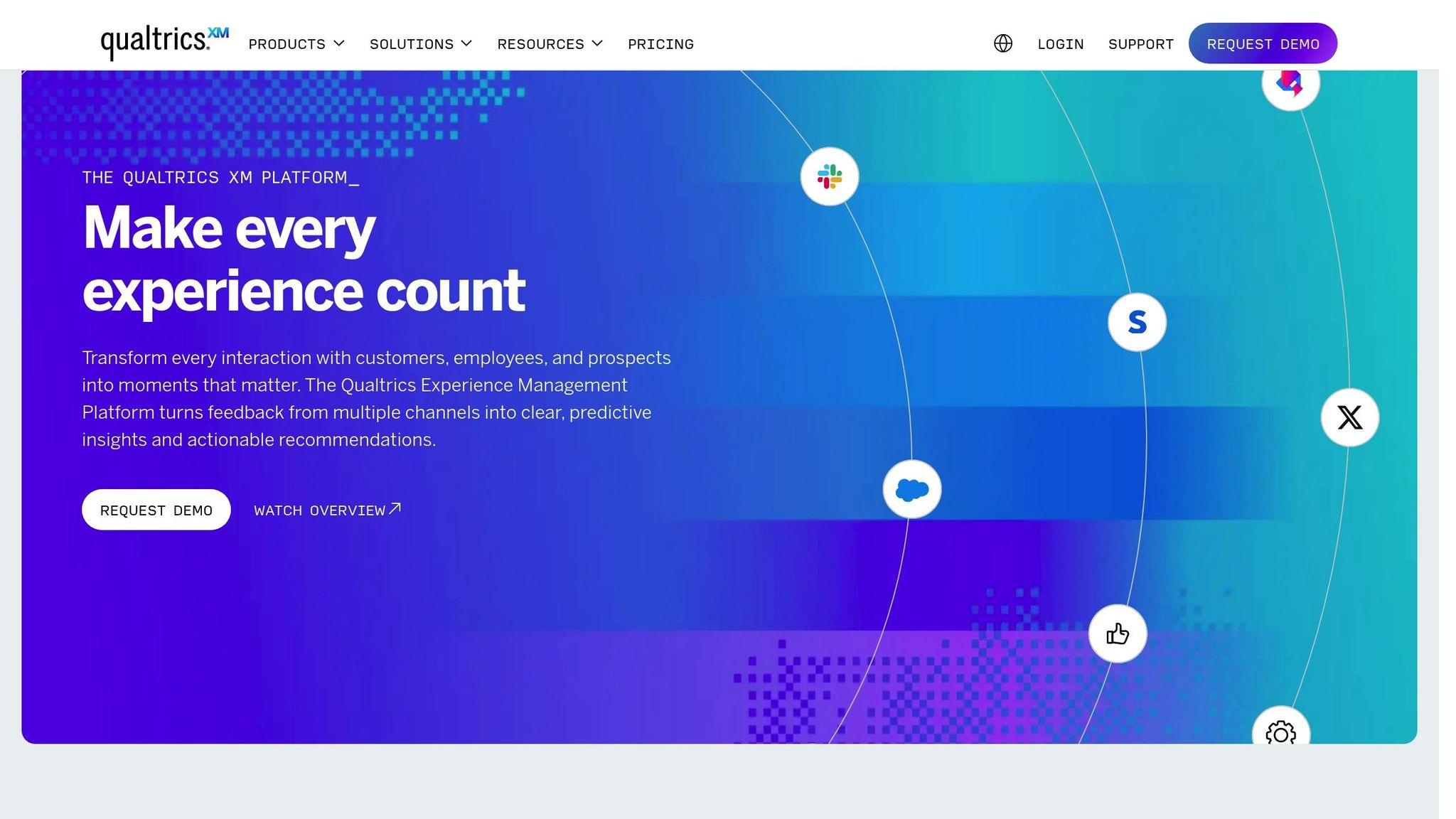
Qualtrics takes customer journey mapping to the next level by combining advanced automation with a robust feedback management system. The Qualtrics XM Platform gathers feedback from every interaction, using AI to transform raw data into meaningful actions that improve the customer experience.
The platform doesn’t just map journeys - it evolves with them. By continuously analyzing customer interactions, it creates dynamic journey maps that adapt to changes in behavior. Its closed-loop feedback system identifies pain points and triggers immediate responses, helping resolve issues before they escalate and strengthening customer loyalty.
Automation Capabilities
Qualtrics simplifies the customer analytics process by automating tasks that would otherwise take hours of manual effort. It evaluates every customer interaction automatically, using predictive analytics to anticipate needs and behaviors. This allows businesses to engage proactively, rather than reacting after the fact.
For contact centers, the platform’s AI zeroes in on specific examples of team performance, highlighting strengths and areas for improvement. Generative AI tools provide real-time coaching to customer service teams, helping them address issues more effectively and turn everyday interactions into opportunities for growth.
AI/ML Features
The platform leverages advanced natural language processing (NLP) and natural language understanding (NLU) to analyze data from text, voice, and digital interactions. It can detect emotions, effort levels, and intent, pinpointing root causes of issues without the need for manual analysis. Conversational analytics offer deeper insights into customer sentiment and friction points, giving businesses a clearer picture of how to enhance the customer experience.
Predictive models built into the platform continuously learn from data, identifying patterns that signal future needs or risks like customer churn. This allows businesses to take proactive steps to address potential problems before they arise.
Integration Options
Qualtrics XM Platform doesn’t operate in isolation - it integrates seamlessly with hundreds of other data sources and business systems. This ensures that journey maps reflect the complete customer experience, not just isolated interactions.
The platform works effortlessly with CRM tools, marketing automation software, and customer service platforms, enabling two-way data flows. Real-time synchronization ensures that insights gained from Qualtrics are immediately available to other systems, and vice versa, keeping journey maps accurate and actionable at all times.
10. Hatrio Sales
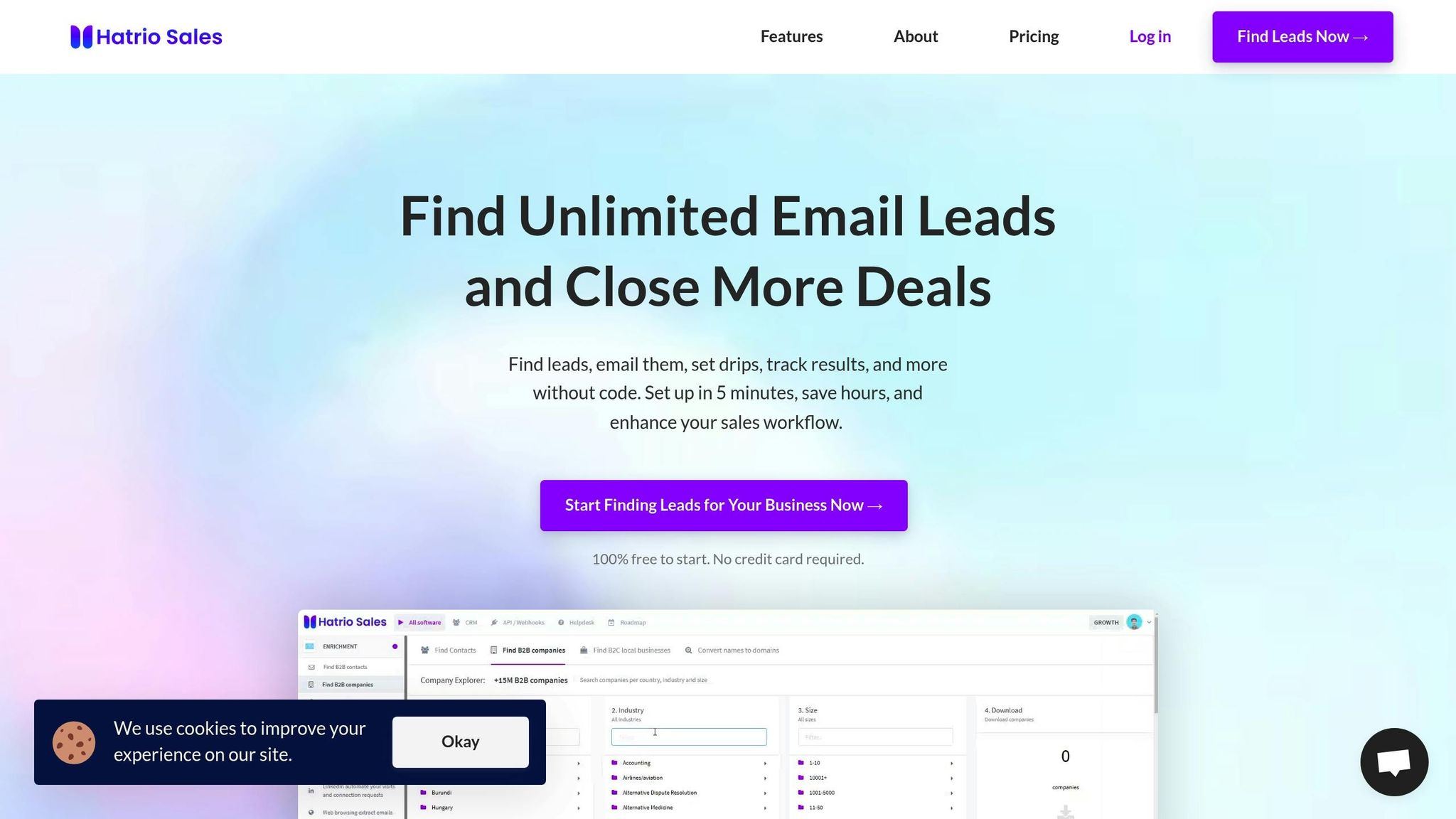
Hatrio Sales is a powerful sales suite designed to streamline the entire sales process - from generating leads to closing deals - while offering a unified view of all customer interactions.
Automation Capabilities
Hatrio Sales takes the hassle out of repetitive tasks with its automation tools. For instance, its drip campaign feature automatically sends personalized follow-up messages when leads interact with specific content. The platform also keeps your sales team on track by updating lead statuses in real-time based on set criteria. These automation flows ensure day-to-day sales operations run smoothly and efficiently.
Integration Options
This platform brings together data from various sources to create a single, detailed customer profile. Whether it's LinkedIn prospecting, email campaigns, CRM activities, or chatbot interactions, all this information is consolidated into one place. To further strengthen sales efforts, Hatrio Sales includes tools like social proof widgets and review management. Plus, its flexible pricing structure allows businesses to scale as their sales team grows.
Pricing (USD)
Hatrio Sales offers three pricing plans to suit different business needs:
- Free Plan ($0/trial): Includes up to 2 users, 500 business leads, 1,000 email exports, 5 drip campaigns, and 500 CRM contacts.
- Growth Plan ($99/month): Perfect for sales professionals and small to medium-sized businesses, offering unlimited users, leads, email exports, drip campaigns, and CRM contacts.
- Enterprise Plan ($249+/month): Designed for larger organizations, this plan provides advanced data features, customized optimizations, and dedicated customer success support.
Tool Comparison Chart
Choosing the best customer journey mapping tool depends on your business needs, budget, and technical requirements. The table below highlights key features and differences across ten popular tools to help you make an informed choice.
| Tool | Core Features | AI/ML Capabilities | Pricing | Best Use Case |
|---|---|---|---|---|
| Fullstory | Session replay, heatmaps, funnel analysis | Predictive analytics, automated insights | $39/month | E-commerce and SaaS companies needing detailed user behavior analysis |
| Miro | Visual collaboration, templates, real-time editing | Limited AI suggestions for layouts | $8/month per user | Cross-functional teams creating collaborative journey maps |
| Heap | Automatic event tracking, retroactive analysis | Machine learning for conversion optimization | $3,600/year | Data-driven organizations requiring comprehensive analytics |
| Smaply | Persona creation, stakeholder maps, journey analytics | Basic pattern recognition | $25/month per user | Service design teams focusing on detailed customer research |
| TheyDo | Opportunity scoring, journey management, team collaboration | AI-powered opportunity identification | $49/month per user | Product teams managing multiple customer journeys |
| Figma | Design collaboration, prototyping, component libraries | AI-assisted design suggestions | $12/month per user | Design teams integrating journey mapping with product design |
| Microsoft Dynamics 365 Customer Insights | CRM integration, customer insights, predictive scoring | Advanced AI for customer predictions | $95/month per user | Enterprise organizations using the Microsoft ecosystem |
| Adobe Experience Platform | Real-time profiles, audience segmentation, campaign orchestration | Adobe Sensei AI for personalization | Custom pricing | Large enterprises with complex omnichannel strategies |
| Qualtrics XM Platform | Survey integration, experience management, statistical analysis | Text analytics and predictive modeling | $1,500/year | Organizations prioritizing customer feedback and experience measurement |
| Hatrio Sales | CRM, lead generation, drip campaigns, sales automation | Lead scoring and enrichment algorithms | Free trial, $99/month Growth plan | Sales teams needing integrated lead management and journey tracking |
The table provides a snapshot of each tool's strengths, but let’s dig into some critical factors to consider.
Ease of Use vs. Feature Depth
Tools like Adobe Experience Platform and Microsoft Dynamics 365 Customer Insights offer extensive features but require technical expertise to implement effectively. On the other hand, platforms like Miro and Figma focus on simplicity, making them ideal for teams without technical backgrounds.
Integration Capabilities
If integration is a priority, Hatrio Sales stands out for its ability to consolidate LinkedIn, CRM, and email campaign data into one platform, streamlining sales and marketing efforts.
Scalability and Cost-Effectiveness
For growing teams, Hatrio Sales offers unlimited users with its $99/month Growth plan, making it an affordable option for expanding sales operations. Meanwhile, enterprise solutions like Adobe Experience Platform cater to large-scale needs but come with custom pricing tailored to complex requirements.
AI and Automation
AI capabilities vary significantly across these tools. TheyDo excels in identifying key opportunities with AI, while Heap focuses on optimizing conversions through machine learning. Hatrio Sales simplifies sales processes with automated lead scoring and drip campaigns.
Implementation Speed
If time is a concern, Miro is operational within days, while enterprise platforms like Adobe Experience Platform may take 3–6 months to fully implement. Hatrio Sales strikes a balance, with teams typically becoming productive in 2–3 weeks thanks to its user-friendly design.
Final Considerations
Your choice ultimately comes down to your team's goals. If visual collaboration is your focus, Miro or Figma might be the best fit. For detailed analytics, consider Fullstory or Heap. Sales teams will benefit from Hatrio Sales, while enterprise users may lean toward Adobe Experience Platform or Microsoft Dynamics 365 Customer Insights. Think about your team’s technical expertise, budget, and primary objectives when deciding.
Conclusion
Automated customer journey mapping has become a game-changer for businesses aiming to stay ahead in today’s competitive landscape. The right tool can reshape how your team understands customer behavior, spots sales opportunities, and boosts revenue.
Choosing the best tool depends on your business's unique needs. For small to medium-sized sales teams, tools like Hatrio Sales offer a streamlined approach by combining CRM capabilities, lead generation, and automated follow-ups - all in one package. This eliminates the hassle of juggling multiple systems. On the other hand, larger enterprises with complex, omnichannel strategies might find platforms like Adobe Experience Platform or Microsoft Dynamics 365 Customer Insights more fitting. These platforms provide the depth and scalability needed for intricate operations, though they do come with longer setup times.
Speed of implementation is another key factor. While enterprise-level solutions often require more time to roll out, tools like Hatrio Sales are built for faster adoption, allowing teams to start seeing results sooner.
Automation plays a crucial role in improving sales performance. From smarter lead scoring and relationship-building through automated campaigns to leveraging social proof with review management tools, automation simplifies and enhances the entire process.
When evaluating tools, consider factors like your team's technical skill set, budget constraints, and main goals. Investing in the right automated customer journey mapping tool can lead to better lead quality, higher conversion rates, and streamlined sales workflows. Refer to the comparison chart above to pinpoint the solution that aligns best with your sales team's needs.
FAQs
How can automated customer journey mapping tools work with CRM systems to improve sales processes?
Automated customer journey mapping tools work hand-in-hand with CRM systems, bringing all customer data together in one place. This setup offers real-time insights into how customers behave, interact, and engage with different touchpoints, making it easier to craft precise and detailed journey maps.
With this data in hand, businesses can spot areas to enhance customer experiences, personalize their communications, and fine-tune sales processes. These tools also empower sales teams to prioritize key leads, refine engagement strategies, and close deals more effectively.
What should businesses look for in an automated customer journey mapping tool?
When choosing an automated customer journey mapping tool, it's crucial to prioritize its ability to connect all customer touchpoints and deliver insights that can drive meaningful improvements in the customer experience. Key features to look for include real-time collaboration, data visualization, and behavior analysis - all of which can help you better understand customer needs and identify problem areas.
You’ll also want to weigh factors like user-friendliness, how well it fits within your budget, and how easily insights can be shared across teams. Tools with strong automation features not only save time but also provide a more accurate view of the customer journey, empowering businesses to make smarter, data-driven decisions.
How do AI and machine learning in customer journey mapping tools help predict customer behavior and improve decision-making?
AI and machine learning are transforming customer journey mapping by effortlessly processing massive datasets to identify patterns in how customers behave. These technologies deliver insights that allow businesses to predict future actions and preferences with a higher degree of precision.
With real-time updates and dynamic journey maps, companies can tailor interactions to individual customers and make smarter decisions. The result? Better customer experiences and strategies that are more effective at keeping customers engaged and loyal.



